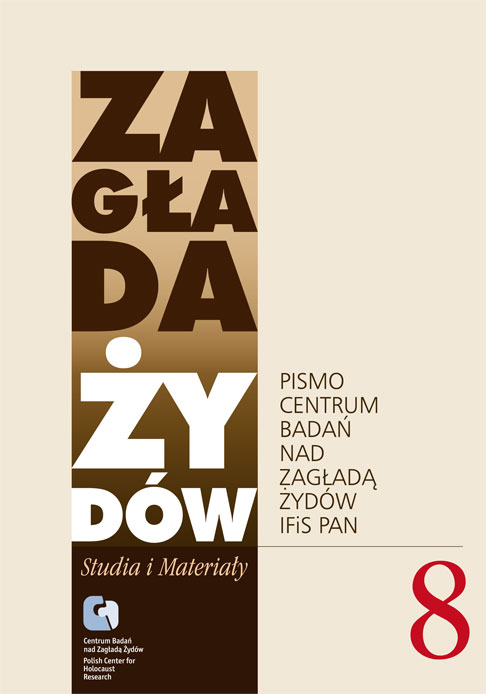Odmienne sylwetki przybyłych do Szwecji więźniów pochodzenia żydowskiego i nieżydowskiego, ocalałych z obozów koncentracyjnych na ziemiach polskich
Zagłada Żydów. Studia i Materiały, Nr 8 (2012), Strony: 419-429
Data zgłoszenia: 2020-12-06Data publikacji: 2012-12-02
 https://doi.org/10.32927/zzsim.698
https://doi.org/10.32927/zzsim.698
Abstrakt
Survivors from Nazi concentration camps, who were brought to Sweden as refugees during the last month of the Second World War and during the summer that followed, were often required to supply information about personal details to the authorities. Much of the information was later stored in written form in the Swedish National Archives. Antisemitism among the refugees and enmity between the Jewish and non-Jewish Polish refugees caused the authorities to include their ethnic or religious affiliation in many records and documents. Using mainly two collections from the Swedish National Archives it is shown that substantial differences existed between Jewish and non-Jewish Polish refugees with respect to their age, education and the length of their war experiences. These differences, in addition to the existing socio-geographic, demographic, cultural and ethnic differences led to inevitable clashes between the two groups. The Swedish authorities who first regarded all refugees of Polish citizenship as one national group had to revise this attitude gradually during the administration of the refugees
Słowa kluczowe
ocalali z Zagłady , Szwecja , stosunki polsko-żydowskie
Licencja
Prawa autorskie (c) 2012 Autor&"Zagłada Żydów. Studia i Materiały"

Utwór dostępny jest na licencji Creative Commons Uznanie autorstwa 4.0 Międzynarodowe.
https://creativecommons.org/licenses/by/4.0
Czasopismo publikowane jest w standardzie Diamond Open Access na licencji CC-BY-4.0 Deed - Uznanie autorstwa 4.0 Międzynarodowa - Creative Commons
Podobne artykuły
- Małgorzata Pakier, Prehistoria pamięci. Zagłada we wczesnym amerykańskim programie rozrywkowym , Zagłada Żydów. Studia i Materiały: Nr 7 (2011)
- Bartłomiej Krupa, O nieobecności Zagłady, czyli czytanie Rozmów z katem Kazimierza Moczarskiego , Zagłada Żydów. Studia i Materiały: Nr 7 (2011)
- Agata Jankowska, Powojenne fotografie z obozów śmierci jako specyficzna odmiana ikonografii Zagłady i przykład fotografii forensycznej. Przypadek Bełżca i Treblinki , Zagłada Żydów. Studia i Materiały: Nr 17 (2021)
- Jacek Leociak, Ruta Sakowska (1922–2011) , Zagłada Żydów. Studia i Materiały: Nr 7 (2011)
- Jan Grabowski, Hunting down Emanuel Ringelblum. The Participation of the Polish Kriminalpolizei in the ‘Final Solution of the Jewish Question , Zagłada Żydów. Studia i Materiały: Nr Holocaust Studies and Materials (2017)
- Justyna Kowalska-Leder, The Omnipresence of the Righteous , Zagłada Żydów. Studia i Materiały: Nr Holocaust Studies and Materials (2017)
- Adam Kopciowski, Robert Kuwałek, Relacja żony Leona Feldhendlera , Zagłada Żydów. Studia i Materiały: Nr 7 (2011)
- Justyna Kowalska-Leder, Andrzej Bart, Fabryka muchołapek, Wydawnictwo W.A.B., Warszawa 2010 , Zagłada Żydów. Studia i Materiały: Nr 6 (2010)
- Jan Grabowski, Dariusz Libionka, Reports on the Jews Apprehended in Warsaw During May–July 1943 Submitted by the ‘Praga’ District of the Polish Police , Zagłada Żydów. Studia i Materiały: Nr Holocaust Studies and Materials (2017)
- Nawojka Cieślińska-Lobkowicz, Śladami nieznanych przedwojennych żydowskich kolekcjonerów i właścicieli dzieł sztuki , Zagłada Żydów. Studia i Materiały: Nr 17 (2021)
<< < 1 2 3 4 5 6 7 8 9 10 11 12 13 14 15 16 17 18 19 20 21 22 23 24 25 26 27 28 29 30 31 32 33 34 35 36 37 38 39 40 41 42 43 44 45 46 47 48 49 50 > >>
Możesz również Rozpocznij zaawansowane wyszukiwanie podobieństw dla tego artykułu.
 English
English
 Język Polski
Język Polski




